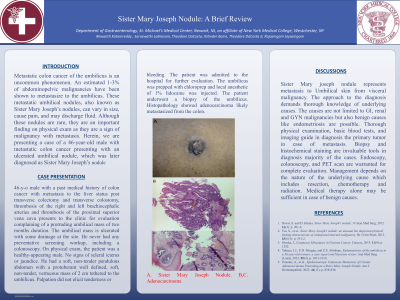Sunday Poster Session
Category: Colon
P0287 - Sister Mary Joseph Nodule: A Brief Review
Sunday, October 22, 2023
3:30 PM - 7:00 PM PT
Location: Exhibit Hall

Has Audio
- RK
Rewanth Katamreddy, MD
Saint Michael’s Medical Center
Newark, New Jersey
Presenting Author(s)
Rewanth Katamreddy, MD1, Saraswathi Lakkasani, MD2, Theodore DaCosta, DO2, Yatinder Bains, MD3, Theodore DaCosta Jr., MD2, Rajasingam Jayasingam, MD3
1Saint Michael’s Medical Center, Newark, NJ; 2Saint Michael's Medical Center, New York Medical College, Newark, NJ; 3Saint Michael's Medical Center, Newark, NJ
Introduction: Metastatic colon cancer of the umbilicus is an uncommon phenomenon. An estimated 1-3% of abdominopelvic malignancies have been shown to metastasize to the umbilicus. These metastatic umbilical nodules, also known as Sister Mary Joseph’s nodules, can vary in size, cause pain, and may discharge fluid. Although these nodules are rare, they are an important finding on physical exam as they are a sign of malignancy with metastasis. Herein, we are presenting a case of a 46-year-old male with metastatic colon cancer presenting with an ulcerated umbilical nodule, which was later diagnosed as Sister Mary Joseph’s nodule
Case Description/Methods: 46-y-o male with a past medical history of colon cancer with metastasis to the liver status post transverse colectomy and transverse colostomy, thrombosis of the right and left brachiocephalic arteries and thrombosis of the proximal superior vena cava presents to the clinic for evaluation complaining of a protruding umbilical mass of two months duration. The umbilical mass is ulcerated with some drainage at the site. He never had any preventative screening workup, including a colonoscopy. On physical exam, the patient was a healthy-appearing male. No signs of scleral icterus or jaundice. He had a soft, non-tender pendulous abdomen with a protuberant well defined, soft, non-tender, verrucous mass of 2 cm tethered to the umbilicus. Palpation did not elicit tenderness or bleeding. The patient was admitted to the hospital for further evaluation. The umbilicus was prepped with chloroprep and local anesthetic of 1% lidocaine was injected. The patient underwent a biopsy of the umbilicus. Histopathology showed adenocarcinoma likely metastasized from the colon.
Discussion: Sister Mary joseph nodule represents metastasis to Umbilical skin from visceral malignancy. The approach to the diagnosis demands thorough knowledge of underlying causes. The causes are not limited to GI, renal and GYN malignancies but also benign causes like endometriosis are possible. Thorough physical examination, basic blood tests, and imaging guide in diagnosis the primary tumor in case of metastasis. Biopsy and histochemical staining are invaluable tools in diagnosis majority of the cases. Endoscopy, colonoscopy, and PET scan are warranted for complete evaluation. Management depends on the nature of the underlying cause which includes resection, chemotherapy and radiation. Medical therapy alone may be sufficient in case of benign causes.

Disclosures:
Rewanth Katamreddy, MD1, Saraswathi Lakkasani, MD2, Theodore DaCosta, DO2, Yatinder Bains, MD3, Theodore DaCosta Jr., MD2, Rajasingam Jayasingam, MD3. P0287 - Sister Mary Joseph Nodule: A Brief Review, ACG 2023 Annual Scientific Meeting Abstracts. Vancouver, BC, Canada: American College of Gastroenterology.
1Saint Michael’s Medical Center, Newark, NJ; 2Saint Michael's Medical Center, New York Medical College, Newark, NJ; 3Saint Michael's Medical Center, Newark, NJ
Introduction: Metastatic colon cancer of the umbilicus is an uncommon phenomenon. An estimated 1-3% of abdominopelvic malignancies have been shown to metastasize to the umbilicus. These metastatic umbilical nodules, also known as Sister Mary Joseph’s nodules, can vary in size, cause pain, and may discharge fluid. Although these nodules are rare, they are an important finding on physical exam as they are a sign of malignancy with metastasis. Herein, we are presenting a case of a 46-year-old male with metastatic colon cancer presenting with an ulcerated umbilical nodule, which was later diagnosed as Sister Mary Joseph’s nodule
Case Description/Methods: 46-y-o male with a past medical history of colon cancer with metastasis to the liver status post transverse colectomy and transverse colostomy, thrombosis of the right and left brachiocephalic arteries and thrombosis of the proximal superior vena cava presents to the clinic for evaluation complaining of a protruding umbilical mass of two months duration. The umbilical mass is ulcerated with some drainage at the site. He never had any preventative screening workup, including a colonoscopy. On physical exam, the patient was a healthy-appearing male. No signs of scleral icterus or jaundice. He had a soft, non-tender pendulous abdomen with a protuberant well defined, soft, non-tender, verrucous mass of 2 cm tethered to the umbilicus. Palpation did not elicit tenderness or bleeding. The patient was admitted to the hospital for further evaluation. The umbilicus was prepped with chloroprep and local anesthetic of 1% lidocaine was injected. The patient underwent a biopsy of the umbilicus. Histopathology showed adenocarcinoma likely metastasized from the colon.
Discussion: Sister Mary joseph nodule represents metastasis to Umbilical skin from visceral malignancy. The approach to the diagnosis demands thorough knowledge of underlying causes. The causes are not limited to GI, renal and GYN malignancies but also benign causes like endometriosis are possible. Thorough physical examination, basic blood tests, and imaging guide in diagnosis the primary tumor in case of metastasis. Biopsy and histochemical staining are invaluable tools in diagnosis majority of the cases. Endoscopy, colonoscopy, and PET scan are warranted for complete evaluation. Management depends on the nature of the underlying cause which includes resection, chemotherapy and radiation. Medical therapy alone may be sufficient in case of benign causes.

Figure: A. Sister Mary Joseph Nodule
B. and C. HPE showing Adenocarcinoma
B. and C. HPE showing Adenocarcinoma
Disclosures:
Rewanth Katamreddy indicated no relevant financial relationships.
Saraswathi Lakkasani indicated no relevant financial relationships.
Theodore DaCosta indicated no relevant financial relationships.
Yatinder Bains indicated no relevant financial relationships.
Theodore DaCosta Jr. indicated no relevant financial relationships.
Rajasingam Jayasingam indicated no relevant financial relationships.
Rewanth Katamreddy, MD1, Saraswathi Lakkasani, MD2, Theodore DaCosta, DO2, Yatinder Bains, MD3, Theodore DaCosta Jr., MD2, Rajasingam Jayasingam, MD3. P0287 - Sister Mary Joseph Nodule: A Brief Review, ACG 2023 Annual Scientific Meeting Abstracts. Vancouver, BC, Canada: American College of Gastroenterology.
